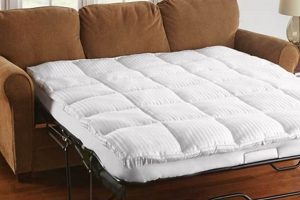The dimensions of a standard futon designed to accommodate two adults are typically 54 inches wide and 75 inches long. This particular measurement allows for comfortable seating and, when unfolded, provides adequate sleeping space comparable to common domestic bed formats. It is a versatile option for various living spaces due to its dual functionality.
The appeal of this spatial configuration lies in its adaptability and efficiency. It offers a practical solution for maximizing limited areas, serving as both a sofa and a bed. Historically, this design reflects a need for multi-purpose furnishings, particularly valuable in smaller apartments or guest rooms where maximizing available area is essential. Its utility extends to serving as an affordable alternative to conventional bedroom sets.
Understanding these spatial parameters is essential for selecting appropriate frames, covers, and linens. Factors such as room dimensions and intended use should influence the ultimate choice. Further considerations should include the material and thickness of the sleeping surface to ensure both comfort and longevity.
Considerations for a Standard Double Futon
Selecting a futon involves assessing its size to ensure it meets spatial and functional requirements. These guidelines offer practical considerations.
Tip 1: Measure Available Space: Before purchasing, accurately measure the intended area. This ensures the futon, when both folded and unfolded, fits comfortably without obstructing pathways or other furniture.
Tip 2: Assess Frame Material: The frame material significantly impacts durability and weight capacity. Solid hardwood frames offer superior support, while metal frames may provide a more lightweight and cost-effective alternative. Ensure the chosen material aligns with expected usage.
Tip 3: Evaluate Mattress Thickness: Mattress thickness dictates comfort levels. Thicker mattresses generally provide better support and pressure relief, particularly for prolonged use as a bed. Consider the intended frequency of use and the user’s comfort preferences.
Tip 4: Research Cover Options: Futon covers protect the mattress and contribute to the overall aesthetic. Opt for durable, stain-resistant fabrics that are easy to clean. Consider the cover’s breathability, especially if the futon will be frequently used for sleeping.
Tip 5: Check Weight Capacity: Every futon frame has a specified maximum weight capacity. Exceeding this limit can damage the frame, compromising its structural integrity and potentially leading to failure. Confirm the weight capacity aligns with the anticipated load.
Tip 6: Evaluate Folding Mechanism: Different futon frames employ varying folding mechanisms. Some are easier to operate than others. Evaluate the ease of conversion from sofa to bed and vice versa, particularly if the transformation will be frequent.
Tip 7: Consider Storage Needs: While most futons do not offer integrated storage, some models provide under-bed clearance. This space can be used for storing bedding or other items. Assess whether storage is a priority and select accordingly.
Careful consideration of these factors allows for informed decision-making, resulting in a futon purchase that aligns with specific needs and preferences. Prioritizing spatial compatibility, material quality, and operational ease ensures long-term satisfaction.
By following these practical tips, individuals can confidently choose a futon that offers both functionality and comfort. This establishes a solid foundation for further exploration into specific style and material choices.
1. Width
The designation of fifty-four inches for the width is a defining characteristic of a full futon mattress. This dimension directly impacts the usability of the futon, both as a seating surface and a sleeping platform. A standard double mattress size is directly responsible for fitting two adults comfortably when in bed position, allowing for free movement and comfort during sleeping hours. A smaller width will compromise the functionality as a bed and a larger measurement will be oversized for most standard rooms.
The 54-inch width influences frame selection. Futon frames are specifically designed to accommodate this dimension, ensuring proper support and preventing mattress overhang or slippage. Consider a situation where a futon mattress of a different width is placed on a full-size futon frame: the result would be an unstable sleeping surface and accelerated wear and tear on both the mattress and the frame. Bedding, such as fitted sheets and mattress protectors, is also manufactured to fit this exact width. Purchasing bedding intended for a twin mattress would prove too narrow, while queen-size bedding would be excessively large.
In conclusion, the fifty-four-inch width is not merely a specification, but an essential component that dictates the overall functionality of the futon. Understanding this dimension is crucial for accurate space planning, frame compatibility, and bedding selection, ensuring optimal usability and comfort. Deviation from this standard impacts the entire user experience, highlighting the importance of adhering to the specified dimensions for practical and effective use of the futon.
2. Length
The seventy-five-inch length is a critical dimension contributing to the classification of a sleeping surface as a full-size futon mattress. Its direct influence on user comfort and spatial efficiency makes its adherence to this measurement imperative. Deviations from this specific length impact the suitability of the futon for its intended purpose. Shortening the length compromises the sleeping space for taller individuals, rendering it unsuitable for comfortable rest. Conversely, lengthening it presents spatial challenges in smaller rooms, disrupting the intended dual functionality of a seating and sleeping solution. The standardized length ensures the futon aligns with common body dimensions and room layouts.
Consider, for instance, a guest room designed to accommodate occasional overnight visitors. A full-size futon mattress with the designated length allows an adult to sleep comfortably without encroaching excessively on the room’s limited area. In contrast, a shorter mattress would leave the user feeling cramped, while a longer one might obstruct doorways or walkways. Similarly, individuals living in studio apartments often rely on the futon’s space-saving design. The seventy-five-inch length allows for both daytime seating and nighttime sleeping without sacrificing too much floor space. This standardized dimension promotes adaptability and ensures compatibility with futon frames engineered to support this precise size.
In conclusion, the seventy-five-inch length is not an arbitrary figure but an integral component of the overall utility of a full-size futon mattress. Its importance rests in its ability to balance user comfort with spatial considerations. An understanding of this dimension is crucial for consumers seeking a practical and versatile furniture solution. Adherence to this standard ensures that the futon fulfills its intended function effectively, providing both a comfortable sleeping surface and a space-efficient seating option.
3. Thickness Variation
Variations in thickness within a full futon mattress significantly influence its overall suitability and functionality, extending beyond mere dimensional specifications. The depth of the mattress affects comfort, support, and compatibility with the futon frame. Assessing thickness variation is therefore critical when considering the total size and intended use of a futon mattress.
- Comfort and Support
Thickness directly correlates with the comfort level a futon mattress provides. A thicker mattress typically offers increased cushioning and pressure relief, particularly beneficial for prolonged use as a bed. Conversely, a thinner mattress may suffice for occasional use as a seating surface. For instance, a mattress exceeding eight inches may contain multiple layers of foam and batting, providing substantial support, whereas a four-inch mattress may offer minimal cushioning and be better suited for infrequent use. The internal composition is critical for assessing long-term comfort.
- Frame Compatibility and Folding
The thickness must correspond with the design of the futon frame. Certain frames are designed to accommodate specific mattress depths. A mattress that is too thick may hinder the frame’s ability to fold properly, preventing it from transitioning smoothly between the sofa and bed positions. Conversely, a mattress that is too thin may not provide adequate support within the frame, potentially leading to sagging or uneven weight distribution. Therefore, matching the mattress thickness to the frame specifications ensures proper functionality and prevents damage.
- Weight and Portability
Thickness affects both the weight and ease of handling of the futon mattress. Thicker mattresses generally weigh more due to the increased amount of material. This can impact portability, making it more difficult to move or store the mattress. Individuals who require a lightweight and easily transportable option may prefer a thinner mattress. For instance, a six-inch mattress is more likely to be lighter and easier to maneuver than a ten-inch mattress. This consideration is particularly relevant for individuals living in smaller spaces or those who frequently rearrange their furniture.
- Durability and Longevity
The thickness may also affect the long-term durability of a futon mattress. Thicker mattresses generally provide more material to absorb wear and tear, potentially extending their lifespan. However, the quality of materials used also plays a significant role. A thicker mattress made from low-quality materials may not last as long as a thinner mattress made from high-quality materials. Regular rotation and proper care are essential for maintaining the integrity of the mattress, regardless of thickness. Factors like material composition (foam density, coil count) play an integral part, too.
In summary, thickness variation directly impacts multiple facets of a full futon mattress. Selecting a mattress of adequate depth provides both comfort and durability, ensuring the selected thickness fits the existing or chosen frame for seamless transition between different modes. These interplaying elements are critical for effective use of the double futon.
4. Folded Height
The folded height of a futon directly correlates with its overall dimensions and influences its suitability for various applications. As a component of the complete unit, the height that a futon attains when folded into its seating configuration dictates the usable area and the ergonomic considerations related to its function as a sofa. The spatial footprint is directly affected; for example, a futon with a greater folded height consumes more vertical space, potentially obstructing views or interfering with overhead fixtures. The seat height determines comfort for users. A dimension too low may cause discomfort when sitting down or standing up. Excessive height affects the user’s feet touching the ground.
Consider a small apartment where space optimization is paramount. A futon with a lower folded height might be preferred to maintain a sense of openness and avoid overwhelming the room. Conversely, in a larger living room, a futon with a more substantial folded height could provide a more visually appealing and comfortable seating arrangement. The selection must balance aesthetics with spatial demands. The folded height dimension also affects the internal mechanism and ease of switching functions. Some models with higher folds will have a mechanical folding design, whereas lower folding futons can have a simple function.
In summation, the folded height warrants careful consideration when selecting a futon. The spatial implications and influence on user comfort require careful assessment. Understanding the interplay between folded height and overall room dimensions is crucial for selecting a futon that balances functionality with spatial harmony.
5. Sleeping Area
The sleeping area, directly determined by the dimensions of a full futon mattress, is a primary factor in its utility as a dual-purpose furniture item. A surface measuring 54 inches wide and 75 inches long dictates the comfort level and capacity for accommodating individuals during sleep. A restricted area compromises the ability to comfortably accommodate two adults, whereas dimensions aligned with standard double mattress sizes provide adequate space for restful sleep. The intended use case, such as frequent overnight guests or everyday sleeping arrangements, dictates the required sleeping area for adequate function. The mattress density is relevant to the user comfort and a comfortable sleeping arrangement, which is the secondary consideration of the sleeping area.
A direct relationship exists between the mattress dimensions and the practicality of a futon. Consider a scenario where the full futon mattress is intended for use in a studio apartment serving as both a living space and a bedroom. An insufficient sleeping area negates its ability to function as a bed, thereby undermining its fundamental purpose. Conversely, a full futon mattress with standard dimensions allows for comfortable sleep without sacrificing excessive floor space during the day. The measurement of the sleeping area needs to be in balance with other components, such as mattress density, durability, and the folding mechanism.
In summary, the sleeping area, defined by the physical dimensions of a full futon mattress, is a critical determinant of its functionality and usefulness. Ensuring adequate space for comfortable sleep is paramount to the futon’s role as a versatile furniture piece, particularly in space-constrained environments. The dimensions need to align with requirements, such as fitting two adults in a studio apartment, which would allow the sleeping function to perform its full design. Understanding this connection is fundamental for selecting a futon that effectively serves its dual purpose as both a seating and sleeping solution.
6. Frame Compatibility
The spatial measurement of a futon directly dictates the requirements for frame compatibility. A full futon mattress, standardized at 54 inches wide and 75 inches long, demands a frame engineered to precisely accommodate these dimensions. Improper matching of the futon mattress to the frame induces a domino effect of issues. Exceeding the frame’s specified size can compromise structural integrity, increasing stress on the frame’s joints. Conversely, a mattress smaller than the frame will result in instability, leading to shifting and discomfort. For instance, using a queen-sized mattress on a full-sized futon frame will cause overhang, making it unstable as a couch, and not fitting securely when opened as a bed.
The ramifications of mismatched measurements extend beyond structural concerns. The designed folding mechanism relies on the precise dimensions to function properly. A mattress too thick may hinder the frame’s ability to transition smoothly between its seating and sleeping configurations. An ill-fitting mattress also impacts aesthetic appeal. An overhanging mattress looks unkempt and compromises the overall design, detracting from the futon’s role as both a functional and visually pleasing furniture piece. The material composition of the frame also needs to support its intended purpose. For example, a heavy wooden frame might need a thick mattress for support, or a metallic frame can be weaker, needing a light mattress that is too thin for support.
Therefore, the selection process must prioritize confirming that the frame’s intended mattress dimensions align exactly with those of the mattress. This ensures structural stability, facilitates proper folding functionality, and optimizes the overall aesthetic. Failing to maintain compatibility will lead to diminished usability, accelerated wear and tear, and compromised user satisfaction. Ultimately, successful integration hinges on strict adherence to dimensional specifications.
7. Weight Distribution
Weight distribution across a futon is inextricably linked to the spatial dimensions of the mattress. A full-size futon mattress possesses a defined surface area that determines how weight is dispersed, impacting comfort, support, and long-term durability. Understanding these principles is crucial for maximizing the lifespan and usability of the futon.
- Even Support and Sagging Prevention
Uniform weight distribution across the sleeping surface is essential to prevent localized sagging. The surface area of a full futon mattress should adequately support the distributed body weight, preventing premature wear in specific areas. Inadequate support leads to concentrated pressure points, reducing comfort and potentially damaging the internal mattress structure. The dimensions have to be correctly followed, such as a 54 inch measurement needs to be adhered to so even distribution is possible.
- Edge Support and Stability
The perimeter dimensions must provide sufficient edge support. A lack of support along the edges of the mattress can cause instability and discomfort when sitting or sleeping near the sides. This effect is amplified if the frame does not precisely match the futon dimensions. The distribution needs to be properly supported by the material that make the frame itself.
- Impact on Frame Stress
Balanced weight distribution minimizes stress on the frame. Uneven weight concentration can lead to warping or breakage of the frame components, particularly in areas bearing the brunt of the load. The frame’s material composition and construction must accommodate the weight distributed across the full surface of the mattress; if not, even minor dimensional issues can compromise its integrity, so all measurements must be correct.
- Two-Person Occupancy Considerations
When occupied by two individuals, the spatial parameters are critical for ensuring balanced and comfortable weight distribution. Insufficient width or length can lead to overcrowding and uneven distribution, resulting in discomfort and potential strain on the mattress and frame. The material and weight must be in balance to ensure the overall use can be done comfortably.
These interconnected facets demonstrate the indispensable role of accurate spatial measurements for optimal weight distribution. Neglecting these fundamental considerations directly undermines the futon’s intended functionality and lifespan, particularly concerning structural integrity, comfort, and long-term usability. Dimensional adherence is thus paramount.
Frequently Asked Questions
This section addresses common inquiries regarding the dimensions of a standard full-size futon mattress. The information provided aims to clarify specifications and their impact on functionality and compatibility.
Question 1: What are the precise dimensions of a standard full-size futon mattress?
A standard full-size futon mattress measures approximately 54 inches in width and 75 inches in length. These dimensions are consistent across most manufacturers, although slight variations may occur due to material composition and construction methods.
Question 2: How does the thickness of a full-size futon mattress impact its comfort and support?
Thickness directly influences the comfort level of a futon mattress. Thicker mattresses generally provide increased cushioning and pressure relief. However, the internal composition of the mattress, including the type and density of foam or batting, also plays a significant role in determining overall support.
Question 3: Can a full-size futon mattress be used on a standard full-size bed frame?
While a full-size futon mattress shares the same width and length dimensions as a standard full-size bed, its construction and intended use differ. A futon mattress is designed to bend and fold on a futon frame. Using it on a standard bed frame may not provide adequate support or comfort.
Question 4: What should be considered when selecting a futon frame to ensure compatibility with a full-size futon mattress?
The selected futon frame must be specifically designed to accommodate a full-size mattress. Verify that the frame’s dimensions precisely match the mattress specifications. Additionally, assess the frame’s weight capacity and construction material to ensure it can adequately support the mattress and its occupants.
Question 5: Are there any alternatives to a full-size futon mattress for smaller spaces?
For spaces where a full-size futon is too large, twin-size or queen-size options may be considered. These alternatives offer reduced dimensions while still providing a dual-purpose seating and sleeping solution. Assess spatial constraints and intended use when selecting a suitable option.
Question 6: How do the dimensions of a full-size futon mattress affect its suitability for different age groups?
The dimensions are generally suitable for both adults and older children. However, individual comfort preferences and physical requirements should be considered. Taller individuals may find a full-size futon mattress too short, while younger children may require a smaller, lower-profile option.
These answers aim to provide a foundational understanding of considerations. Proper research and evaluation are crucial before making a final purchasing decision.
Proceeding to the next section will further explore care and maintenance guidelines.
Size of a Full Futon Mattress
This exploration has systematically detailed the critical parameters of “size of a full futon mattress.” The standard dimensions, 54 inches in width and 75 inches in length, fundamentally dictate its function, comfort, and spatial utility. Deviations from these specifications compromise its intended dual-purpose design. Considerations of thickness, folded height, and frame compatibility further influence its suitability for diverse applications, affecting weight distribution and overall support.
The informed selection of a futon, therefore, necessitates a comprehensive understanding of these measurements. Recognizing their impact is paramount to optimizing functionality and ensuring long-term satisfaction. Future trends may introduce variations in materials and construction, but the core dimensions will continue to be the defining characteristics that establish its role as a space-efficient and versatile furniture option.


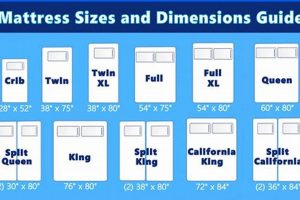
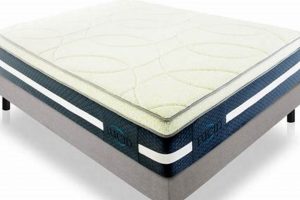
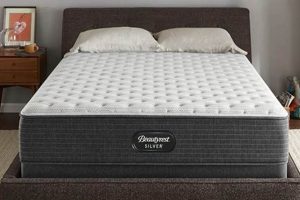
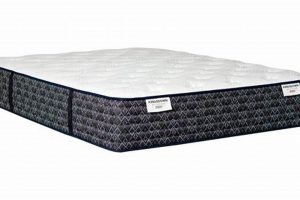
![Best Plush Full Size Mattress [Guide] For Comfort Sleep Organic & Natural Mattress Buyer’s Guide: Non-Toxic Sleep Solutions Best Plush Full Size Mattress [Guide] For Comfort Sleep | Organic & Natural Mattress Buyer’s Guide: Non-Toxic Sleep Solutions](https://mattressworldpa.com/wp-content/uploads/2025/07/th-2793-300x200.jpg)
